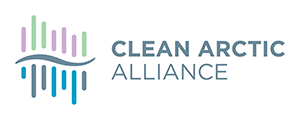Black Carbon in the Arctic
![]()
Around the world, ships typically burn the cheapest and dirtiest fuel left over from the oil refining process – heavy fuel oil (HFO), which produces high levels of black carbon when burned.
When ships burn HFO, they produce black carbon particles, which are emitted into the environment via their exhaust fumes. These short-lived climate forcers contribute to the warming of the Earth’s atmosphere and when they fall on snow, or on glacier ice and sea ice, they reduce the reflectivity, or albedo, of that surface — and consequently increase how much heat it absorbs.More Arctic shipping using HFO will lead to increased black carbon emissions, further fuelling an already accelerating feedback loop. The International Maritime Organization’s HFO ban will only reduce the volume of black carbon emissions by a mere 5 percent.
About 20% of global shipping’s climate warming impacts on a twenty year basis can be attributed to black carbon – the remainder being CO2. When emitted by ships in and near the Arctic, black carbon particles enter the lower levels of the atmosphere, where they remain for under two weeks, absorbing heat. But when it eventually comes to land on snow or ice, black carbon’s warming impact is 7 to 10 times greater, as it reduces the reflectivity (albedo) and continues to absorb heat, accelerating the Arctic melt.
Although shipping only contributes 2% of the black carbon in the Arctic, it has a much greater heating impact, as other sources of black carbon are higher in the atmosphere with less chance of falling on ice and snow. While most anthropogenic sources of black carbon pollution are being reduced in the Arctic, shipping emissions of black carbon have risen 8% globally in the past decade, and in the Arctic by 85% between 2015 and 2019 alone. With climate warming driving the ongoing loss of multi-season Arctic sea ice, the region is opening up to more shipping traffic; between 2013 and 2019 data published by the Arctic Council showed a 25% increase in shipping traffic and a 75% increase in the total distance sailed in the Arctic, we can expect that further increases in black carbon emissions from shipping will only further contribute to an already accelerating feedback loop.
In June 2021, the International Maritime Organization (IMO), the UN body which governs shipping, adopted a ban on the use and carriage of HFO in the Arctic. Although environmental and Indigenous groups had fought for years for the Arctic to be free of HFO, the ban contains serious loopholes which will mean minimal reductions in the use and carriage of HFO in 2024 when implemented. Meanwhile current growth in Arctic shipping is likely to lead to an increase in HFO use and carriage in the Arctic between now and mid-2024 when the ban takes effect, and further growth by mid-2029, when the loopholes will finally be closed. Under this regime, black carbon emissions are likely, for now, to continue to increase in the Arctic.
The International Maritime Organization must urgently put in place strong measures to drive fast deep cuts in CO2 and black carbon emissions from ships, especially those operating in and near to the Arctic.
How did the IMO Come to Work on Black Carbon Emissions from Shipping?

